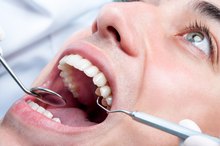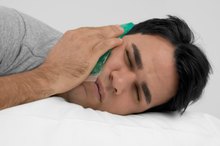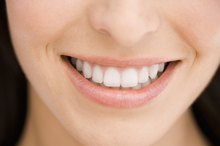A Toothache in the Tooth With a Crown
People often assume that once you get a crown, you’ll never experience another problem with that tooth. But a crowned tooth is as susceptible to the same dental ailments as any other tooth, as well as certain problems related specifically to the crown. These ailments and problems commonly manifest as a toothache. Pain can occur immediately after the crown is placed or develop months to years later.
Dental Cement and Bite Changes
A toothache that develops soon after a crown is placed is likely related to the gluing process or an uneven bite. Dental cements that glue the crown in place are acidic or rely on acidic primers, which can irritate the nerve in a tooth 1. This can cause pain or temperature sensitivity that usually lasts a few days, but can persist for up to a year. New crowns can also cause pain if the fit is slightly off and causes an uneven bite. If the crowned tooth meets the opposing teeth before all the others when biting down, pain will likely persist until the crown is filed down.
- A toothache that develops soon after a crown is placed is likely related to the gluing process or an uneven bite.
Cavities Under Crowns
Alternatives for Root Canals
Learn More
Even with a crown, a new cavity can develop at the border of the tooth and the crown, in the same way a cavity can form at the edge of a filling. A cavity is caused by dental plaque buildup leading to tooth decay. If the decay spreads beneath the crown or deeply into the tooth, the nerve tissue becomes inflamed and painful. Should bacteria from the decay reach the nerve itself, root canal therapy or removal of the tooth is necessary to clear the infection. Root canal therapy in a crowned tooth involves drilling a small hole into the crown to remove the infected nerve and surrounding tissue in the tooth roots.
- Even with a crown, a new cavity can develop at the border of the tooth and the crown, in the same way a cavity can form at the edge of a filling.
- Should bacteria from the decay reach the nerve itself, root canal therapy or removal of the tooth is necessary to clear the infection.
Root Death and Root Fracture
A tooth that requires a crown was rarely normal beforehand. Crowns are often needed because of deep or large cavities. Even when the tooth is crowned, the nerve may have been sufficiently damaged by the preexisting tooth problem that it dies. This can lead to a localized infection, a tooth abscess, which generally requires root canal therapy. Occasionally, even after such treatment, the infection comes back and further treatment may include replacing the crown. Additionally, like any other tooth, a crowned tooth sometimes develops a fracture in the root. When this occurs, the tooth needs to be removed.
- A tooth that requires a crown was rarely normal beforehand.
- Occasionally, even after such treatment, the infection comes back and further treatment may include replacing the crown.
Gum Issues and Cement Failure
Side Effects of Dental Veneers
Learn More
The gums around a crowned tooth can recede with time, exposing part of the root and leading to hot or cold sensitivity, or both. Gum recession is often associated with excessively forceful tooth brushing. Areas of gum recession are particularly susceptible to developing plaque buildup, which can lead to a painful gum infection.
Cement leakage at the edge of the crown occurs in some people. This may be associated with pain in the tooth, although it is unclear whether leakage can actually cause pain. Failure of the cement to bond properly -- resulting in the crown moving or even coming off -- may also cause pain in a crowned tooth.
- The gums around a crowned tooth can recede with time, exposing part of the root and leading to hot or cold sensitivity, or both.
- Areas of gum recession are particularly susceptible to developing plaque buildup, which can lead to a painful gum infection.
Follow Up
Contact your dentist as soon as possible if you develop a toothache in a crowned tooth. Whether the crown is new or established, a dental professional can investigate the cause of the pain and intervene, if necessary. Early diagnosis and treatment of problems in a crowned tooth offers the best chance of saving the tooth.
Reviewed by: Tina M. St. John, M.D.
- Contact your dentist as soon as possible if you develop a toothache in a crowned tooth.
Related Articles
References
- Operative Dentistry: A Clinical Comparison of Two Cements for Levels of Post-operative Sensitivity in a Practice-Based Setting
- International Endodontic Journal: Fate of Vital Pulps Beneath a Metal-Ceramic Crown or Bridge Retainer
- Journal of Prosthetic Dentistry: Clinical Complications in Fixed Prosthodontics
- Adnan, S., & Muhammad Atif , A. (2018). Gingival Retraction Techniques: A Review. Dental Update, 45(4). doi:10.12968/denu.2018.45.4.284
- Nawareg MM, Zidan AZ, Zhou J, Chiba A, Tagami J, Pashley DH. Adhesive sealing of dentin surfaces in vitro: A review. Am J Dent. 2015;28(6):321-32.
Writer Bio
Jack Klausner has published extensively in clinical journals, including the Am Dental Assoc, Pain Medicine and Clinical Sleep Medicine. Klausner has been involved in pain research and is assistant-professor at New York University College of Dentistry, where he received his dental degree. He is a contributor to the blog hometest4.









